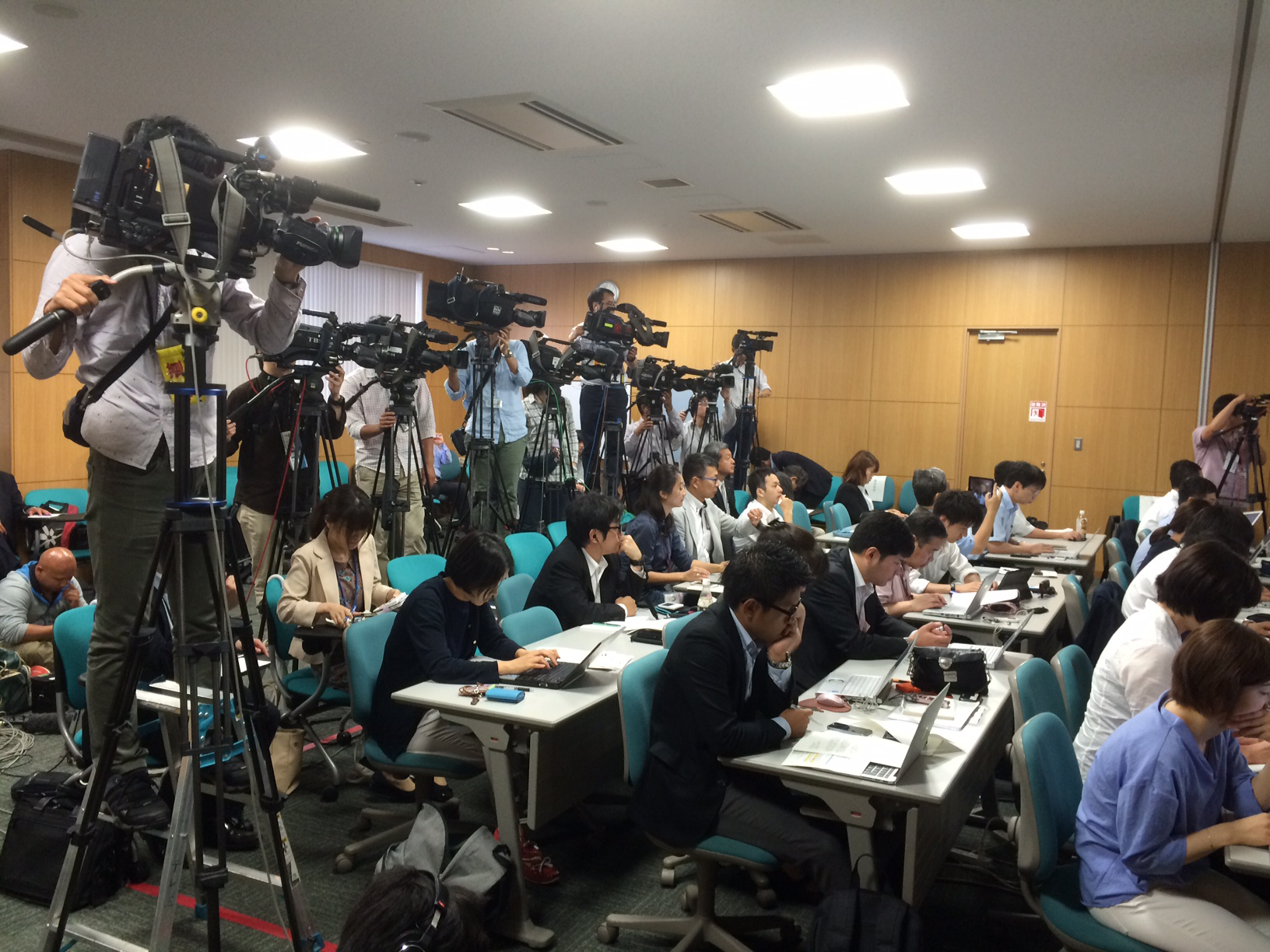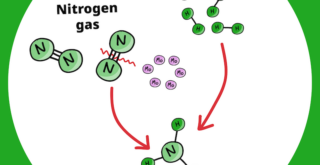Without any initial presentation, they went right into a Q&A session. The questions ranged widely, from why they chose nihonium rather than japonium or nipponium, to how their plans were going for the discovery of elements beyond 118, the heaviest element on the periodic table today.
I thought that one of the most interesting things to come up was the story of why they chose nihonium and not nipponium. Just as background, in Japanese, the country Japan is called Nihon or Nippon, two pronunciations for the same written word (日本). So in explaining their choice, Morita said that didn’t consider nipponium because it was actually disqualified. The reason being that it has already been used in the periodic table, and once this happens, even briefly, a name is “retired” from the table like player numbers in sports.

An old periodic table from 1909 showing nipponium (Np). Source: Supplement to the Chemical News, Dec 10, 1909 (hover to find it)
What it led to, then, was the fascinating story of Masataka Ogawa, a chemist who thought he had found element 43—known as technetium today—and called it nipponium. It appeared in periodic tables at least in 1909, the year following the discovery. But unfortunately, others were not able to replicate his findings, and he was not given credit (according to Wikipedia, six other groups also claimed to have found it at various times between 1828 and 1925). Element 43 was finally discovered in 1936, and given the name technetium. However, it was recently hypothesized that Ogawa had actually discovered the element below technetium in the periodic table, element 75, which was is now known as rhenium, having been discovered officially 17 years later. If not for his mistake, we would have had an element named after Japan more than 100 years ago. The details of this story are really interesting, and can be found in a (free!) paper by Kenji Yoshihara that was published in 2008.
Morita was also asked about his favorite element, and answered fluorine, mentioning that it is such a reactive substance. I imagine that a lot of people might say gold or platinum, or perhaps oxygen, so it was an interesting choice.
The last question came from a reporter from a children’s newspaper, who asked the researchers for messages. Morita said “take an interest in something—whatever you want—and pursue that interest,” and Morimoto said, “Don’t be afraid to fail.”
The room was packed with reporters and when, at the end of the meeting, he stood at the front of the room holding up a periodic table with the new element, he was mobbed by the photographers trying to get the perfect shot. ◼︎
Without any initial presentation, they went right into a Q&A session. The questions ranged widely, from why they chose nihonium rather than japonium or nipponium, to how their plans were going for the discovery of elements beyond 118, the heaviest element on the periodic table today.
I thought that one of the most interesting things to come up was the story of why they chose nihonium and not nipponium. Just as background, in Japanese, the country Japan is called Nihon or Nippon, two pronunciations for the same written word (日本). So in explaining their choice, Morita said that didn’t consider nipponium because it was actually disqualified. The reason being that it has already been used in the periodic table, and once this happens, even briefly, a name is “retired” from the table like player numbers in sports.

An old periodic table from 1909 showing nipponium (Np). Source: Supplement to the Chemical News, Dec 10, 1909
What it led to, then, was the fascinating story of Masataka Ogawa, a chemist who thought he had found element 43—known as technetium today—and called it nipponium. It appeared in periodic tables at least in 1909, the year following the discovery. But unfortunately, others were not able to replicate his findings, and he was not given credit (according to Wikipedia, six other groups also claimed to have found it at various times between 1828 and 1925). Element 43 was finally discovered in 1936, and given the name technetium. However, it was recently hypothesized that Ogawa had actually discovered the element below technetium in the periodic table, element 75, which was is now known as rhenium, having been discovered officially 17 years later. If not for his mistake, we would have had an element named after Japan more than 100 years ago. The details of this story are really interesting, and can be found in a (free!) paper by Kenji Yoshihara that was published in 2008.
Morita was also asked about his favorite element, and answered fluorine, mentioning that it is such a reactive substance. I imagine that a lot of people might say gold or platinum, or perhaps oxygen, so it was an interesting choice.
The last question came from a reporter from a children’s newspaper, who asked the researchers for messages. Morita said “take an interest in something—whatever you want—and pursue that interest,” and Morimoto said, “Don’t be afraid to fail.”
The room was packed with reporters and when, at the end of the meeting, he stood at the front of the room holding up a periodic table with the new element, he was mobbed by the photographers trying to get the perfect shot. ◼︎
Without any initial presentation, they went right into a Q&A session. The questions ranged widely, from why they chose nihonium rather than japonium or nipponium, to how their plans were going for the discovery of elements beyond 118, the heaviest element on the periodic table today.
I thought that one of the most interesting things to come up was the story of why they chose nihonium and not nipponium. Just as background, in Japanese, the country Japan is called Nihon or Nippon, two pronunciations for the same written word (日本). So in explaining their choice, Morita said that didn’t consider nipponium because it was actually disqualified. The reason being that it has already been used in the periodic table, and once this happens, even briefly, a name is “retired” from the table like player numbers in sports.

An old periodic table from 1909 showing nipponium (Np). Source: Supplement to the Chemical News, Dec 10, 1909
What it led to, then, was the fascinating story of Masataka Ogawa, a chemist who thought he had found element 43—known as technetium today—and called it nipponium. It appeared in periodic tables at least in 1909, the year following the discovery. But unfortunately, others were not able to replicate his findings, and he was not given credit (according to Wikipedia, six other groups also claimed to have found it at various times between 1828 and 1925). Element 43 was finally discovered in 1936, and given the name technetium. However, it was recently hypothesized that Ogawa had actually discovered the element below technetium in the periodic table, element 75, which was is now known as rhenium, having been discovered officially 17 years later. If not for his mistake, we would have had an element named after Japan more than 100 years ago. The details of this story are really interesting, and can be found in a (free!) paper by Kenji Yoshihara that was published in 2008.
Morita was also asked about his favorite element, and answered fluorine, mentioning that it is such a reactive substance. I imagine that a lot of people might say gold or platinum, or perhaps oxygen, so it was an interesting choice.
The last question came from a reporter from a children’s newspaper, who asked the researchers for messages. Morita said “take an interest in something—whatever you want—and pursue that interest,” and Morimoto said, “Don’t be afraid to fail.”
The room was packed with reporters and when, at the end of the meeting, he stood at the front of the room holding up a periodic table with the new element, he was mobbed by the photographers trying to get the perfect shot. ◼︎
Reporters attending the meeting with Kosuke Morita to learn the proposed name of element 113. Credit: Jens Wilkinson








